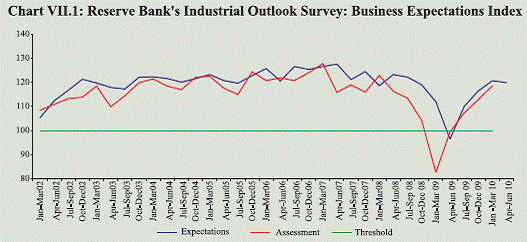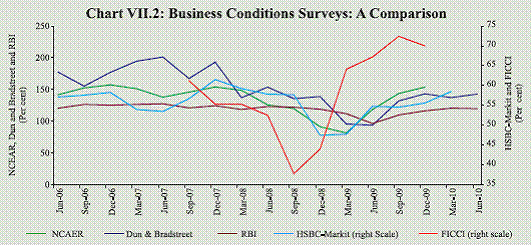VII. Macroeconomic Outlook - ಆರ್ಬಿಐ - Reserve Bank of India
VII. Macroeconomic Outlook
Various forward looking surveys in the recent period generally point to an improvement in business sentiments, besides the prospects of further acceleration in economic activities in the forthcoming quarters. The Industrial Outlook Survey conducted by the Reserve Bank shows improvement in the sentiments in the manufacturing sector, in continuation of the trend seen in the previous survey. The professional forecasters’ survey of the Reserve Bank suggests an overall (median) GDP growth of 8.2 per cent for 2010- 11. Stronger growth impulses now coexist with significant acceleration in headline inflation in recent months. While the recovery in growth is expected to further firm up in 2010-11 over the preceding year, headline inflation could be expected to moderate over the next few months. VII.1 After witnessing a slowdown during 2008-09, the economy has recovered in 2009-10, which is expected to firm up further and take hold in 2010-11. Continuing the optimism witnessed in the previous business confidence surveys, the bullish sentiments have grown stronger. The industrial outlook survey of the Reserve Bank indicates improved assessment of the January-March 2010 quarter. The professional forecasters’ survey conducted in March 2010 shows overall (median) growth rate for 2010-11 at 8.2 per cent, driven mainly by increased private consumption expenditure growth and relatively increased industrial activity in the first half and pick-up in services in the second half. Business Expectation Surveys VII.2 The forward looking surveys conducted by various agencies generally convey an optimistic picture about the economy. While almost all the surveys report strong Y-o-Y improvements, the picture about sequential Q-o-Q growth is somewhat mixed (Table VII.1) VII.3 Business Confidence Index (BCI) of the National Council of Applied Economic Research (NCAER) increased to 156.8 in April 2010, registering a gain of 2.0 per cent over its January 2010 level (Table VII.1). This is the fourth successive quarter in which the BCI has registered an increase. Among the four components, ‘investment climate’ and ‘capacity utilisation’ were weaker as compared to the earlier quarter, but expectations about improvement in ‘overall business conditions’ and ‘financial position of firms’ in the next six months rose substantially, thus driving the increase in the BCI.
VII.4 The Business Confidence Survey of the FICCI for Q3:2009-10, which was released in February 2010, suggests that 83 per cent of the companies felt the overall current economic conditions to be “moderately to substantially better”. Going ahead, around 77 per cent of the companies feel that the economic conditions would improve further in the coming six months. The overall business confidence index contracted by 3.3 per cent over the previous quarter on account of anxiety over withdrawal of stimulus measures. The outlook for jobs, according to the survey, has somewhat improved, with 30 per cent firms stating that they would add to their employee strength in the coming six months. VII.5 The Dun and Bradstreet Business Optimism Index (BOI) for Q2:2010 increased by 4.0 per cent to 142.8 over Q1:2010 on account of improvement in overall business sentiment. However, some cautiousness on account of high inflation and expected hardening of interest rates is visible from relatively lower optimism with regard to volume of sales, new orders, net profits and employee levels during Q2:2010 as compared to Q1:2010. On a Y-o-Y basis, the BOI for the Q2:2010 recorded a sharp increase of 52.2 per cent, corroborating the fact that the economy is firmly on a revival path. Improving domestic demand, surge in domestic stock markets, increase in advance tax collections, increased capital inflows and stabilising export demand seem to have supported the optimism in the business sentiments. VII.6 The CII Business Confidence Index for October 2009-March 2010 increased by 7.4 points to 66.1 on top of the 2.4 point increase during the first half of 2009-10. Nevertheless, according to the survey, uncertain global economic outlook and slackening consumer demand continue to affect confidence levels. VII.7 The seasonally adjusted HSBC Markit Purchasing Managers’ Index (PMI) (manufacturing) which had recorded a twenty month high in February 2010 witnessed a marginal fall in March 2010 largely reflecting weaker expansion of both output and new orders. Notwithstanding this fall, the index which reached a level of 57.8 in March 2010, has remained in the above neutral territory (above 50 mark) in each of the past twelve months. It is noteworthy that the strong rise in domestic new orders had been driving the index in recent months. The survey also revealed a sharp rise in input prices, which in turn may be reflected in higher output prices, thus building up supply side pressures on inflation. VII.8 The HSBC Markit Services PMI complemented the trend in manufacturing PMI. The Services PMI declined to 58.1 in March 2010 from the seventeen month peak of 60.9 witnessed in February 2010. In the case of services as well, both input prices and prices charged in the services sector registered some increase. Reserve Bank’s Industrial Outlook Survey VII.9 The 49th round of Industrial Outlook Survey of the Reserve Bank conducted during January-March 2010 showed improvement in assessment for the same quarter (Table VII.2). The expectations for the quarter April-June 2010, however, exhibited marginal moderation as compared to January-March 2010 quarter, partly reflecting seasonality. The index, though, remained significantly higher as compared to the corresponding quarter last year. It is noteworthy that in line with the trend witnessed since Q2: 2009-10, both indices (i.e. assessment about the current quarter and expectations about the next quarter) remained in the growth terrain (i.e., above 100, which is the threshold that separates contraction from expansion) (Chart VII.1).
VII.10 The survey reveals that for the assessment quarter, an optimistic view was expressed about the demand conditions. For the forthcoming quarter, however, deterioration in production capacity and capacity utilisation are anticipated by the respondents, reflecting an expected slowdown in demand. The respondents also expect the financial conditions to be adversely affected in the next quarter as reflected in an expected decline in working capital finance requirement and availability of finance. Notwithstanding this, the respondents expect their profit margins to increase as compared to the present quarter. Furthermore, as a sign of gradual return of the pricing power, the selling prices are expected to increase at a higher rate as compared to the previous quarter. VII.11 The findings of various surveys on business conditions largely reflect similar pattern (Chart VII.2).
Survey of Professional Forecasters1 VII.12 The results of the eleventh round of ‘Survey of Professional Forecasters’ conducted by the Reserve Bank in March 2010 places overall (median) growth rate for 2010-11 at 8.2 per cent, driven mainly by increased private consumption expenditure growth, stronger industrial activity in first half and further pick-up in services in the second half (Table VII.3). The sectoral growth rate forecast for 2010-11 suggests upward revision for agriculture and industry. The forecast for the agriculture sector growth was revised upwards to 4.0 per cent from 3.5 per cent. The forecast for industry was also revised upwards to 9.0 per cent from 8.1 per cent. For services, however, the forecasts remained constant at 9.0 per cent. The overall (median) growth rate for 2009-10 was revised upward to 7.2 per cent, as against 6.9 per cent reported in the earlier survey. Growth Projections of Different Agencies VII.13 The CSO advance estimates for GDP growth for 2009-10 at 7.2 per cent suggest that the economy has outperformed the earlier projections of most of the agencies, leading to subsequent upward revisions (Table VII.4). Various agency estimates suggest that this uptrend in growth rate is expected to continue in the next financial year as well. Factors Influencing the Current Growth and Inflation Outlook VII.14 The economic recovery in 2009-10 so far has been driven by a turnaround in the industrial output and continuing resilience of the services sector. At this juncture, the strong outlook for growth points to significant improvement in the overall macroeconomic conditions while the substantial firming up of headline inflation in recent months has emerged as a key concern. VII.15 The growth outlook for the Indian economy in the near term remains positive on account of the following factors: (a) expectations of satisfactory rabi output, which may offset, partially, the decline in kharif output; (b) expectations that the industrial sector would remain buoyant; (c) increase in corporate sales and profitability; (d) pick-up in order books and capacity utilisation as per different survey results; (e) turnaround in exports with improving global conditions; (f) pick-up in lead services indicators for transportation, telecommunication and construction, and (g) revival in credit demand from the private sector. VII.16 Notwithstanding the overwhelming positive sentiments about stronger growth in the near term, certain downside risks remain: (a) the revival in growth of agriculture during 2010-11 hinges on the assumption of normal monsoon, which entails the usual uncertainties; (b) while investment demand is showing signs of picking up, it is still much below the rate of growth in the pre-global crisis period; (c) the private consumption demand, which accounts for about 60 per cent of aggregate demand, needs to gain significant momentum; (d) decline in saving rate last year, led by sharp decline in public sector savings; (e) global economic recovery, though clearly visible, is still weak and thus has implications for sustaining the growth in Indian exports; and (f) the rising inflation, which may push costs through demand for higher wages and increase in input costs. VII.17 The headline inflation, which remained at 9.9 per cent in February-March 2010, has emerged as a major policy concern. In the recent weeks, while food inflation is showing signs of slowdown, inflation in fuel and manufactured products is causing more generalised inflationary pressures. Going forward, following factors may exert further upward pressures on inflation: (a) on the supply side, international commodity prices, especially of crude oil and industrial inputs have been rising in the recent months, thus limiting the option of imports that could contain inflation in India; (b) return of pricing power of the corporates with stronger revival in demand; (c) on demand side, revival in private consumption demand coupled with revival in growth of credit and money supply, and (d) the gradual exit of the fiscal stimulus measures which has and would entail roll back of excise and customs duty reliefs as well as measures to align domestic prices with international oil prices. VII.18 While the near-term factors corroborate the acceleration in inflation seen so far, certain factors could help in dampening the inflationary pressures, which include: (a) satisfactory rabi production and arrival of new crops in the market that could improve the supply conditions; (b) a normal monsoon that may translate into improvement in agricultural production, and (c) the impact of monetary policy actions already initiated by the Reserve Bank to anchor inflationary expectations. VII.19 The conflicting pulls of supporting the recovery and anchoring inflationary expectations continue to pose a challenge for the conduct of monetary policy. While recovery in private demand needs to be stronger to make the growth process selfsustaining, recent strong pick-up in headline inflation has emerged as a key policy concern, since high inflation itself may hamper the recovery in growth. The near-term outlook suggests that economic growth in 2010-11 will be higher than in 2009-10. Inflation, in turn, could be expected to moderate in next few months, from the peak levels seen in recent months, reflecting easing of supply pressures and the impact of necessary policy actions. In sum, there is an overall improvement in business sentiments and economic activity, but concerns relating to elevated levels of inflation remain in the near term. It is likely that the growth impulses could further strengthen during 2010-11, and therefore, anchoring inflationary expectations without hurting the growth process continue to be the focus of monetary policy. 1 Introduced by the Reserve Bank from the quarter ended September 2007. The forecasts reflect the views of professional forecasters and not of the Reserve Bank. |
||||||||||||||||||||||||||||||||||||||||||
























